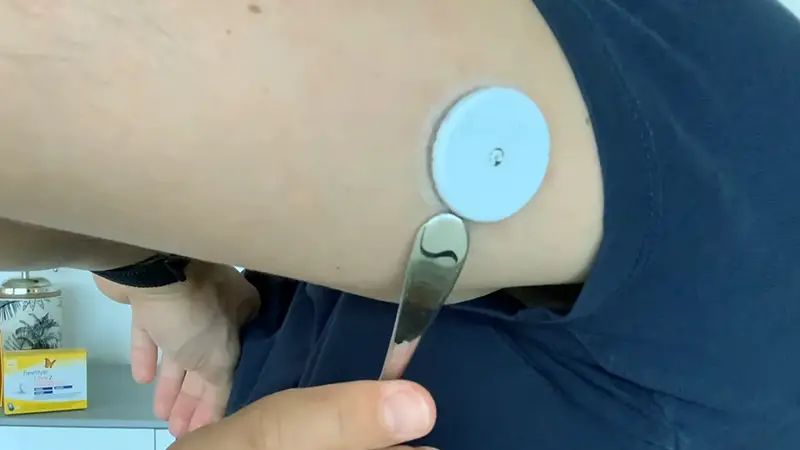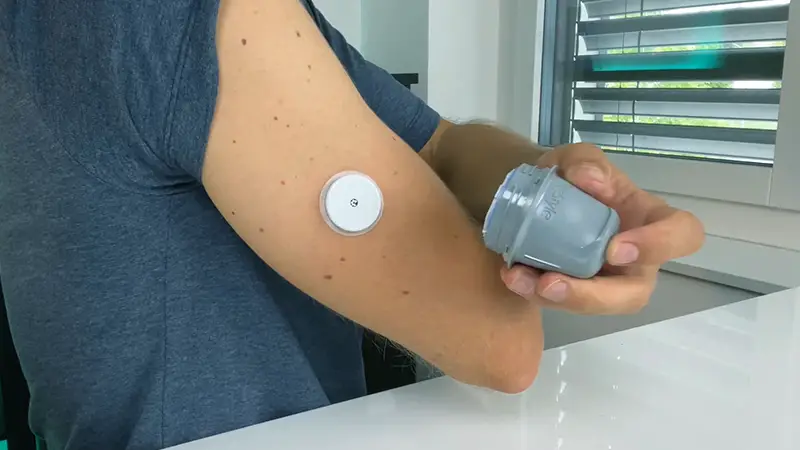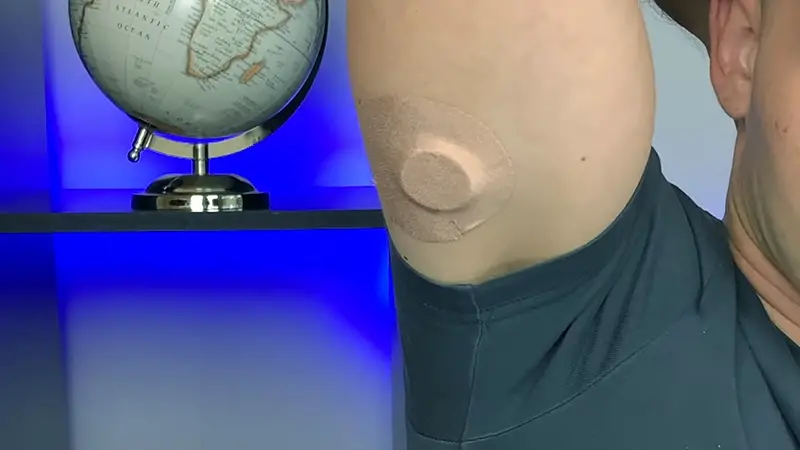Managing diabetes with a Freestyle Libre continuous glucose monitoring (CGM) system offers convenience and real-time insights into blood sugar levels.
However, for some users, a recurring challenge arises – the Freestyle Libre sensor falling off prematurely.
This issue can be frustrating, as it affects the reliability of glucose data and disrupts diabetes management routines. In this blog post, we will explore common reasons behind the question, Why does my freestyle libre keep falling off?
From proper skin preparation to adhesive products designed for the sensor, we will cover a range of strategies to ensure that your CGM system functions optimally.
Discover how to address this common concern and regain confidence in your diabetes monitoring with the Freestyle Libre system. So, stay focused.
What Is Freestyle Libre?

The Freestyle Libre is a continuous glucose monitoring (CGM) system designed for people with diabetes. It consists of a small sensor placed on the skin’s surface that measures glucose levels in the interstitial fluid.
Unlike traditional glucose monitoring, it doesn’t require fingerstick blood tests, making it more convenient and less invasive.
Users can scan the sensor with a reader or smartphone to instantly view their current glucose levels, historical data, and trends.
This real-time information helps individuals with diabetes manage their condition more effectively by making informed decisions about diet, exercise, and insulin dosing.
The Freestyle Libre has revolutionized diabetes management, offering greater freedom and improved quality of life for those living with the condition.
How Does Freestyle Libre Sensor Work?

The Freestyle Libre sensor works based on a technology called continuous glucose monitoring (CGM). Here’s how it works:
Sensor Placement
The Freestyle Libre sensor consists of a small, disposable, and flexible wire-like filament that is inserted just under the skin, typically on the back of the upper arm.
This process is done using an applicator and is relatively painless.
Interstitial Fluid Measurement
Once placed, the sensor measures glucose levels in the interstitial fluid, which is the fluid that surrounds the body’s cells. Glucose levels in the interstitial fluid closely mirror those in the bloodstream.
Data Collection
The sensor continuously monitors glucose levels and records this information at regular intervals, usually every few minutes.
Scanning or Reader
To access the data, users can either scan the sensor using a dedicated Freestyle Libre reader or a compatible smartphone with the Freestyle LibreLink app.
This scanning process is done by holding the reader or smartphone near the sensor.
Glucose Readings
When scanned, the sensor transmits the glucose readings to the reader or smartphone, displaying the current glucose level, historical data, and trends on the screen.
Real-Time Monitoring
Users can see their glucose levels in real-time, enabling them to make immediate decisions about managing their diabetes, such as adjusting their diet, exercise, or insulin doses.
Data Storage
The Freestyle Libre system typically stores glucose data for up to 8 hours, allowing users to track patterns over time.
Why Does My Freestyle Libre Keep Falling Off?

The Freestyle Libre sensor staying securely in place is essential for accurate and continuous glucose monitoring.
If your Freestyle Libre sensor keeps falling off, there could be several reasons for this issue, and here are some common solutions to help keep it in place:
Proper Placement
Ensure that the sensor is placed on a clean, dry, and hair-free area of your skin. Oily or hairy skin can make it difficult for the sensor adhesive to stick.
Clean Skin
Clean the application site with mild soap and water, and ensure it’s thoroughly dry before applying the sensor. Avoid using lotions, creams, or oils on the site.
Adhesive Prep
Some users find success by using an adhesive barrier wipe or spray on the skin before applying the sensor. This can help create a better bond between the sensor adhesive and your skin.
Secure Application
Make sure you apply the sensor correctly using the provided applicator, and press down firmly to ensure it sticks well. Hold it in place for a few seconds after application to let the adhesive bond.
Skin Type
Individuals with very dry or sensitive skin may encounter more difficulty with sensor adhesion. If this is the case, consult with your healthcare provider for recommendations or alternatives.
Avoid Sweating
Excessive sweating can weaken the adhesive. Consider using a waterproof adhesive patch or tape to secure the sensor during physical activities or hot weather.
Additional Adhesive
Some users find it helpful to use additional adhesive patches specifically designed for Freestyle Libre sensors. These can provide extra support and help keep the sensor in place.
Consult Your Healthcare Provider
If you continue to have issues with the sensor falling off, consult with your healthcare provider or diabetes educator.
They may have specific recommendations or alternatives based on your individual circumstances.
Solutions and Tips for Freestyle Libre Keeps Falling Off

If your Freestyle Libre sensor keeps falling off, it can be frustrating, but there are several solutions and tips you can try to improve adhesion:
Properly Clean and Prepare the Skin
- Clean the application site with mild soap and water, and ensure it’s completely dry before applying the sensor. Avoid using lotions or oils on the site, as they can interfere with adhesion.
- Use alcohol wipes to clean the area, but allow it to dry completely before applying the sensor.
Choose an Ideal Application Site
- Opt for areas of your body with less hair, as hair can interfere with adhesion. Common sites include the back of the upper arm, abdomen, or thigh.
- Avoid areas that experience a lot of friction, bending, or rubbing.
Apply Proper Pressure
When applying the sensor, press it down firmly and hold it in place for several seconds. This helps the adhesive bond to your skin.
Use an Adhesive Barrier
Consider using an adhesive barrier wipe or spray designed for use with medical adhesives. This can help improve adhesion and protect your skin.
Additional Adhesive Products
Many users find success with over-the-counter adhesive products designed specifically for Freestyle Libre sensors. These adhesive patches or tapes can help secure the sensor in place.
Skin Preparation and Barrier Products
Experiment with different skin preparation and barrier products, such as skin prep wipes or barrier wipes, which can help create a better surface for adhesion.
Avoid Sweating and Moisture
Excessive sweating or moisture can weaken the adhesive. Use additional adhesive covers or patches, especially during activities that may cause you to sweat.
Monitor Application Technique
Ensure that you follow the proper technique for applying the sensor using the provided applicator. Check if there are any issues with the sensor insertion itself.
Consult Your Healthcare Provider
If the problem persists despite trying these solutions, consult with your healthcare provider or diabetes educator.
They may have specific recommendations or alternative methods for sensor placement.
Consider Alternative Sites
Depending on your body and lifestyle, you might find that certain locations work better for sensor adhesion. Experiment with different sites to see which one provides the best results.
Remember that maintaining secure sensor adhesion is crucial for accurate glucose monitoring.
When to Seek Professional Help When Freestyle Libre Keeps Falling Off?

If you’re experiencing ongoing issues with your Freestyle Libre sensor falling off despite trying various solutions and tips, it’s a good idea to seek professional help.
Here are some indicators of when to consult with a healthcare provider or diabetes educator:
Frequent Adhesion Problems
If the sensor consistently falls off shortly after application or if it becomes a recurrent issue, it’s a sign that you may need expert guidance.
Infection or Skin Irritation
If you notice signs of infection or skin irritation at the application site, such as redness, swelling, itching, or discharge, consult a healthcare professional promptly. They can assess the issue and recommend appropriate treatment.
Consistently Inaccurate Readings
If you suspect that adhesion issues are affecting the accuracy of your glucose readings, it’s essential to address the problem with a healthcare provider.
They can help determine whether the sensor placement is impacting the device’s performance.
Limited Application Sites
If you find that you have limited suitable application sites due to skin conditions, allergies, or other factors, a healthcare provider can offer guidance on alternative locations or adhesive solutions.
Allergic Reactions
In rare cases, individuals may experience allergic reactions to the adhesive or materials in the sensor. If you suspect an allergy, consult a healthcare provider for an evaluation and possible allergy testing.
Chronic Adherence Problems
If you have diabetes and are continually struggling with sensor adhesion, it can affect your ability to manage your condition effectively. Seek help to avoid disruptions in your glucose monitoring routine.
Changes in Your Skin
If there are changes in your skin, such as unusual moles or skin conditions at the sensor application site, it’s essential to have them evaluated by a healthcare provider.
Persistent Frustration
If dealing with adhesion issues is causing stress, frustration, or negatively impacting your diabetes management, don’t hesitate to reach out to a healthcare professional for support and solutions.
When you consult with a healthcare provider or diabetes educator, they can assess your individual circumstances, and potentially provide alternative adhesive products or sensor options that better suit your needs.
FAQs
Why does my Freestyle Libre sensor keep falling off?
Freestyle Libre sensors may fall off due to factors like oily or hairy skin, inadequate skin preparation, or excessive sweating. Ensuring clean, dry skin and proper sensor application can improve adhesion.
Can I reuse a sensor that fell off prematurely?
It’s not recommended to reuse a sensor once it falls off, as it may affect accuracy and hygiene. Replace it with a new sensor to ensure reliable glucose monitoring.
Are there specific adhesive products for Freestyle Libre sensors?
Yes, there are adhesive patches and tapes designed for Freestyle Libre sensors. These can provide extra support and help keep the sensor in place.
Can I apply the sensor to different body locations if it keeps falling off?
Yes, you can experiment with different body sites, like the back of the upper arm, abdomen, or thigh, to find the one that offers better adhesion and comfort.
What should I do if I experience skin irritation or allergies from the sensor adhesive?
If you experience skin irritation or allergies, consult with a healthcare provider. They can recommend barrier products, allergy testing, or alternative adhesive solutions to address the issue.
Wrapping Up
A Freestyle Libre sensor that keeps falling off should not stand in the way of effectively managing your diabetes.
By implementing the solutions and tips discussed in this blog post, you can overcome adhesion challenges and enjoy consistent, accurate glucose monitoring.
Remember the importance of proper skin preparation, choosing suitable application sites, and exploring adhesive products when needed.
A secure sensor ensures you have the reliable data needed to make informed decisions about your diet, exercise, and insulin dosing. Don’t let adhesion issues hinder your journey to better diabetes management.
With these strategies, you can get the most out of your Freestyle Libre CGM system and regain control of your health. Best wishes.
I am a fitness enthusiast who has been in the industry for over 10 years. I’ve been in this position since 2008 and have seen it grow from a small start-up to a large corporation.
I’m the President-CEO at Precision Fitness Equipment, Inc. and I work with our team of experts to ensure that we provide the best fitness equipment for our customers.